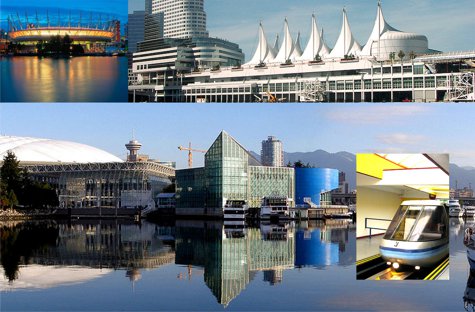
The 1986 World Exposition on Transportation and Communication, or simply Expo '86, was a World's Fair held in Vancouver, British Columbia, Canada from Friday, May 2 until Monday, October 13, 1986. The fair, the theme of which was "Transportation and Communication: World in Motion - World in Touch", coincided with Vancouver's centennial and was held on the north shore of False Creek. It was the second time that Canada held a World's Fair, the first being Expo 67 in Montreal (during the Canadian Centennial). It was also the third World's Fair to be held in the Pacific Northwest in the last 25 years as of 1986 and as of 2012 it still stands as the latest World's Fair to be held in North America.
You'll want to Click Here to take a look back.
The logo of three interlocking rings to make the 86 in the logo stood for the three main modes of transportation; land, air, and water.
Up until the late 1970s, the 173 acre (0.7 km2) site on False Creek, where Expo was staged, was a former CPR rail yard and an industrial wasteland. In 1978, Sam Bawlf (then BC Minister of Recreation and Conservation) proposed an exposition to celebrate Vancouver’s Centennial year (1986). The proposal was submitted in June 1979, for a fair that was to be called “Transpo 86.” In 1980, the British Columbia Legislature passed the Transpo 86 Corporation Act, paving the way for the fair. The transportation theme reflected the city’s role in connecting Canada by rail, its status as a major port and transportation hub, and the role of transportation in communications.
The initial idea was to have “…a modest $80 million transportation exposition that would mark Vancouver’s 100th anniversary.” It soon blossomed into a full exposition thanks to the help of the Vancouver Exposition Commissioner-General at that time, Patrick Reid. The theme of Transportation and Communication led to the conglomeration of many different exhibits of transportation networks. This included a monorail that glided over the crowds that included a trip to every zone. Other ground transports included a Skytrain, a High Speed Surface Transport from Japan, and a French “People Mover.” (basically a little boxcar). The transports of the sky was the Gondola, a boxcar hovering high in the air. The water taxis moved along four different ports on the site.
The fair was awarded to Vancouver by the Bureau of International Expositions in November 1980. However, once it became clear that the event would be a world exposition, the name was officially changed to “Expo 86″ by Ambassador and Commissioner General Patrick Reid in October 1981, and, by the end of the year, Expo 86 Corporation was established as a nonprofit agency responsible in the planning and operation of the fair.
Local business tycoon Jim Pattison was appointed as CEO, and would eventually also become the president of the corporation. The chief architect selected was Bruno Freschi, the Creative Director was Ron Woodall, and Bob Smith was responsible for the production and design.
Construction started in October 1983, when Elizabeth II, Queen of Canada, started a concrete mixer on the future site of the Canada Pavilion, and offered the “invitation to the world.” But, work was disrupted by labour disputes for 5 months. Still, Expo Centre opened May 2, 1985, as a preview centre for the fair.
The fair was originally budgeted for a modest CAN$78 million. However, final expeditures for the expanded event totaled $802 million with a deficit of CAN$311 million.
Expo ’86 was opened by Charles, Prince of Wales, Diana, Princess of Wales, and Prime Minister Brian Mulroney on Friday, May 2, 1986. It featured pavilions from 54 nations and numerous corporations. Expo’s participants were given the opportunity to design their own pavilion or opt for the less expensive Expo module. Each module was approximately two-and-a-half stories high and had the floor space equal to a third of a city block. The design was such that any number of the square modules could be placed together in a variety of shapes. The roof design allowed the interior exhibit space to be uninterrupted by pillars.
Source: Wikipedia


